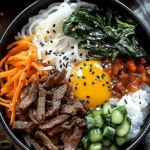The ultimate comfort food with a crispy twist—Japanese Katsu Bowls with Tonkatsu Sauce bring together golden panko-breaded cutlets, sweet-tangy sauce, and fresh cabbage over a bed of warm rice. Whether you choose pork or chicken, the juicy interior and crisp exterior make this dish irresistibly satisfying.
This meal is easy to customize, perfect for weeknight dinners, and fun to assemble with toppings like sesame seeds, pickled ginger, or a jammy egg. Once you try your hand at the rich homemade tonkatsu sauce, you’ll never go back to store-bought. A guaranteed hit for cozy nights or impressive weekend spreads.
Full Recipe:
For the Katsu:
-
2 boneless pork chops or chicken breasts, pounded thin
-
Salt and pepper
-
½ cup all-purpose flour
-
1 large egg, beaten
-
1 cup panko breadcrumbs
-
Vegetable oil, for frying
For the Tonkatsu Sauce:
-
¼ cup ketchup
-
2 tbsp Worcestershire sauce
-
1 tbsp soy sauce
-
1 tbsp mirin or rice vinegar
-
1 tbsp brown sugar
-
1 tsp Dijon mustard (optional)
For the Bowl:
-
Steamed white or brown rice
-
Thinly shredded cabbage
-
Optional toppings: green onions, sesame seeds, pickled ginger, fried egg
Directions:
-
Prepare the Cutlets:
Pound pork or chicken to an even thickness. Season both sides with salt and pepper. Dredge in flour, dip in beaten egg, then coat with panko breadcrumbs. -
Pan-Fry:
Heat vegetable oil in a skillet over medium heat. Fry cutlets for 3–4 minutes on each side until golden brown and crispy. Transfer to a wire rack or paper towel to drain. -
Make the Sauce:
In a small saucepan, combine ketchup, Worcestershire, soy sauce, mirin, brown sugar, and mustard. Simmer for 2–3 minutes until thickened. Set aside. -
Assemble the Bowls:
Divide rice among bowls. Slice the cooked katsu and place on top of the rice. Drizzle with tonkatsu sauce. Add shredded cabbage and optional toppings as desired.
Prep Time: 15 minutes | Cooking Time: 20 minutes | Total Time: 35 minutes
Kcal: ~520 kcal | Servings: 2 bowls
Introduction: A Bowl of Comfort and Crunch
Japanese cuisine is renowned for its delicate balance of flavors, textures, and aesthetics. Among its many beloved dishes, the katsu bowl—especially when topped with tonkatsu sauce—stands out as a perfect harmony of comfort and crunch. This dish, also known as a Katsu Donburi when served with eggs or sauce over rice, combines a golden, panko-crusted cutlet with a hearty base of fluffy rice and crisp cabbage. But it’s the tangy-sweet tonkatsu sauce that elevates this dish into something unforgettable.
Originating as a Japanese adaptation of Western-style breaded cutlets, “katsu” has evolved into a versatile, crave-worthy staple in Japanese households and restaurants. The bowl format allows for customizability, making it an ideal dish for both busy weeknights and indulgent weekend meals.
The History of Katsu in Japanese Cuisine
The term katsu is short for katsuretsu, which means “cutlet” in Japanese. Katsu was introduced in Japan in the late 19th century, inspired by European meat cutlets. Over time, the Japanese transformed it by using panko breadcrumbs instead of regular ones, resulting in a lighter, airier, and crispier texture.
Initially served as part of a Western-style meal (yōshoku), katsu gradually made its way into the mainstream Japanese culinary repertoire. Today, you’ll find numerous variations, including tonkatsu (pork), chicken katsu, menchi katsu (ground meat patties), and even vegetarian versions made with tofu or eggplant.
Katsu bowls represent a relatively modern presentation, emphasizing convenience without sacrificing quality. They bring all the traditional elements together in a compact, customizable, and satisfying format.
Why Katsu Bowls Are So Popular
The popularity of katsu bowls can be attributed to several factors:
-
Texture Contrast: The crispy, fried exterior of the katsu contrasts beautifully with the soft, steamy rice and crunchy raw cabbage.
-
Flavor Depth: Tonkatsu sauce adds a bold, umami-rich layer with hints of sweetness and tanginess.
-
Simplicity and Versatility: Despite tasting complex, the ingredients are straightforward and highly adaptable.
-
Meal Prep Friendly: Katsu and the sauce can be made ahead, making it great for lunches or quick dinners.
The dish appeals to both children and adults, and it holds up well to reheating, making it ideal for meal prepping or leftovers.
What Sets Homemade Katsu Bowls Apart
While store-bought tonkatsu sauce and frozen katsu cutlets are available, making the dish from scratch provides a far superior culinary experience. Homemade tonkatsu sauce offers a richer, fresher flavor profile that you can adjust to your taste—add more sweetness, increase the acidity, or spice it up with a dash of chili oil or sriracha.
Pounding and breading the meat yourself ensures even cooking and a better texture. Additionally, frying the cutlet just before serving maintains that addictive crunch, which often gets lost in prepackaged or reheated versions.
Moreover, you have full control over the ingredients—making it easy to avoid additives, opt for gluten-free alternatives, or switch to organic produce and proteins.
Customizing Your Katsu Bowl
One of the strengths of the katsu bowl is how adaptable it is to dietary needs and preferences. Here are some creative twists and variations:
-
Protein Variations: Try chicken thighs for juicier meat, or substitute with tofu, tempeh, or eggplant for a vegetarian spin.
-
Cooking Methods: Use an air fryer or oven instead of pan-frying to reduce oil without sacrificing too much crunch.
-
Sauce Modifications: Enhance the tonkatsu sauce with grated garlic, ginger, or even a splash of citrus for brightness.
-
Base Swaps: Swap traditional white rice for brown rice, cauliflower rice, or even soba noodles for a low-carb or gluten-free option.
-
Toppings Galore: Add a jammy soft-boiled egg, pickled daikon, sesame seeds, or even nori strips to layer in extra flavor and texture.
This level of flexibility makes katsu bowls a go-to in many households.
What Makes Tonkatsu Sauce So Irresistible
Tonkatsu sauce is arguably the soul of this dish. A Japanese spin on Worcestershire sauce, it includes a base of ketchup or tomato paste, soy sauce, and sugar, often blended with vinegar, spices, and fruits for depth. Some recipes include Dijon mustard for a mild kick.
The sauce is thick enough to cling to the katsu without making it soggy, and its combination of sweet, sour, and umami flavors perfectly complements the savory crunch of the breaded cutlet. Unlike thin sauces or broths, tonkatsu sauce ties the bowl together in a rich and flavorful ribbon.
Once you taste a homemade version, the bottled varieties often pale in comparison.
Serving Suggestions and Meal Pairings
Katsu bowls are satisfying on their own, but pairing them with complementary sides can enhance the meal further. Consider the following:
-
Garlic or sesame roasted vegetables like Brussels sprouts, green beans, or asparagus.
-
Miso soup for a light, warm contrast.
-
Pickled sides such as tsukemono, kimchi, or pickled ginger for acidity and crunch.
-
Japanese potato salad for creaminess that balances the katsu’s crispness.
Beverage pairings can include hot green tea, iced barley tea (mugicha), or even a crisp lager or dry sake for adults.
Tips for Best Results
-
Pound your meat evenly so it cooks uniformly without drying out.
-
Use panko breadcrumbs for that signature crispy exterior.
-
Let the breaded cutlets rest for 5-10 minutes before frying—this helps the coating adhere better and reduces splatter.
-
Maintain proper oil temperature (around 340–350°F or 170–175°C) to prevent sogginess or burning.
-
Drain fried cutlets on a wire rack to retain crunch rather than using paper towels, which can trap steam.
Taking the time to follow these practices ensures a result that’s restaurant-worthy, every time.
Storing and Reheating
Katsu bowls are not just delicious fresh—they’re great as leftovers too. Here’s how to store them:
-
Store the components separately (cutlet, rice, sauce) to preserve texture.
-
Reheat the katsu in an oven or air fryer to bring back its crispiness.
-
Keep the tonkatsu sauce refrigerated for up to one week—it may even taste better the next day.
This makes it easy to double the recipe and enjoy it throughout the week.
Conclusion: Why Katsu Bowls Deserve a Spot in Your Weekly Rotation
Japanese Katsu Bowls with Tonkatsu Sauce are the perfect example of comfort food that doesn’t cut corners on texture or taste. With their balance of crispy, juicy, sweet, and savory elements, they provide a deeply satisfying meal that hits every craving note.
They’re also practical—easy to prepare, meal-prep friendly, and endlessly customizable. Whether you’re cooking for one, a family, or entertaining friends, katsu bowls are sure to impress. And once you master the homemade tonkatsu sauce and perfect your frying technique, you’ll never feel the need to order takeout again.
This dish is more than just a meal—it’s a celebration of flavor, texture, and Japanese culinary tradition, all in one beautifully balanced bowl.





